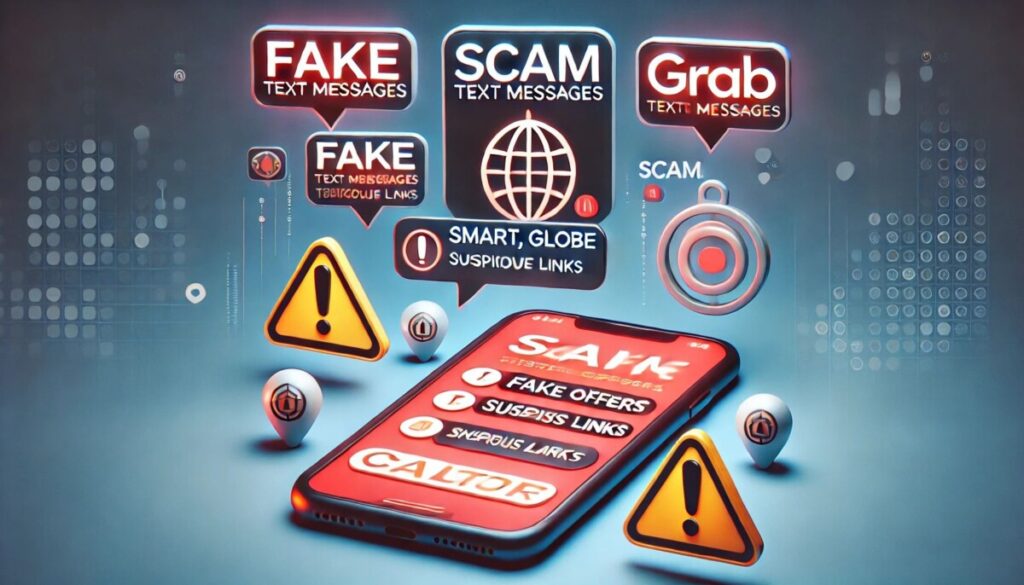With the rise of digital communication, scammers have also become more creative in their schemes. Many Filipinos have reported receiving text messages that appear to come from reputable companies like SMART, Globe, or Grab. Unfortunately, these messages are often fraudulent attempts to steal personal information, known as phishing or smishing (SMS phishing).
In this blog, we’ll explore what these scams are, how to recognize them, and what to do if you receive such messages.
What Are Phishing and Smishing?
Phishing is a scam where fraudsters impersonate legitimate entities to steal sensitive information, such as passwords, credit card details, or personal data. Smishing is a subset of phishing, conducted via SMS or text messages.
These messages often:
- Appear to come from official companies.
- Contain urgent language to provoke immediate action.
- Include links to fake websites or prompt you to reply with personal information.
Understanding Spoofing in Scam Texts
Spoofing occurs when scammers manipulate the sender’s information to appear as a trusted source, such as a legitimate phone number or email address. In the case of scam texts, they may appear to come from well-known companies like SMART, Globe, or Grab, making it harder to identify them as fraudulent. Always be cautious when receiving unsolicited messages, especially if they ask for sensitive information or direct you to suspicious links. Spoofed messages are designed to deceive, so trust your instincts and verify before acting.
How to Recognize a Scam Text

Here are some red flags to watch for:
1. Unverified Sender
- Official companies like SMART, Globe, and Grab use shortcodes (e.g., 1234) or verified sender IDs.
- Scam texts often come from random mobile numbers.
2. Suspicious Links
- Legitimate companies use official domain names (e.g., smart.com.ph, globe.com.ph, grab.com).
- Scammers use URLs with slight misspellings or unfamiliar domains.
3. Urgent or Threatening Language
- Claims like “Your account will be suspended,” “Verify now,” or “You won a prize” are common tactics to pressure you.
4. Requests for Personal Information
- Official companies will never ask for sensitive details like passwords, OTPs, or PINs via text.
Examples of the latest Scam Texts
- “Globe reminds you that you have 3022 points that will expire tomorrow. Click the link now to redeem an air fryer for free. Expired points will be reset to zero: https://globe.zsjfh.art/ph”
- “SMART: You have 9,521 points in your account, scheduled to expire soon. Redeem them now to enjoy exclusive rewards. Act promptly to avoid losing your points! https://smastpolmt.cc”
- “GRAB: Grab reminds you that you have 3022 points that will expire tomorrow. Click the link now to redeem a tablet for free. Expired points will be reset to zero: https://grabrewards.top/i”
Clicking on suspicious links in scam texts can lead to various risks, including:
- Phishing: You may be tricked into providing sensitive information such as passwords, credit card details, or personal identification.
- Malware Installation: The link could lead to malicious software that infects your device, stealing your data or causing damage.
- Scam Transactions: Clicking may redirect you to fraudulent websites, where you might unknowingly complete transactions or subscribe to paid services.
Always verify the source and be cautious of any unsolicited links.
What to Do If You Receive a Scam Text
Here are steps to protect yourself:
1. Do Not Click Any Links
Avoid clicking on any links included in the text. These may lead to fake websites designed to steal your information or infect your device with malware.
2. Do Not Respond
Avoid replying to the text, even if it’s to “stop” or “unsubcribe.” Responding may confirm to the scammer that your number is active.
3. Verify with the Company
Contact the official customer service of SMART, Globe, or Grab to verify if the message is legitimate.
4. Report the Scam
Most telecom companies have systems in place to report fraudulent messages:
- For SMART Subscribers:
- Forward the scam text to 7726 (SPAM) for free.
- Alternatively, email cybersecurity@smart.com.ph.
- For Globe Subscribers:
- Forward the scam text to 7726 (SPAM) for free.
- Alternatively, email phishing@globe.com.ph.
- For Grab:
- Report the incident via the Grab app’s Help Center.
- Email safety@grab.com with details of the text.
5. Block and Delete the Number
Use your phone’s blocking feature to prevent further messages from the sender.
How to Stay Safe from Smishing
Preventive measures can help you avoid falling victim to these scams:
- Enable Spam Filters Most smartphones and telecom providers have spam detection features. Turn these on to filter unwanted messages.
- Be Skeptical Always question unexpected texts, especially those asking for immediate action or personal information.
- Use Two-Factor Authentication (2FA) Enable 2FA for your online accounts. This adds an extra layer of security even if your details are compromised.
- Educate Yourself and Others Share information about these scams with family and friends to raise awareness.
Conclusion
Receiving scam texts can be alarming, but staying informed and cautious is the best defense. By recognizing the signs of smishing and taking the appropriate steps, you can protect yourself and others from falling victim to these fraudulent schemes.
If you found this guide helpful, share it with others to spread awareness and keep everyone safe from phishing scams.


